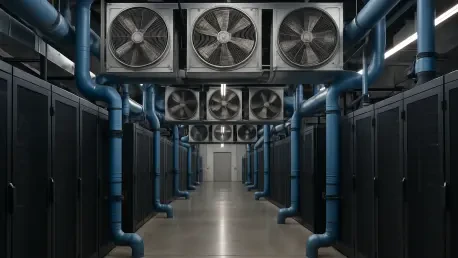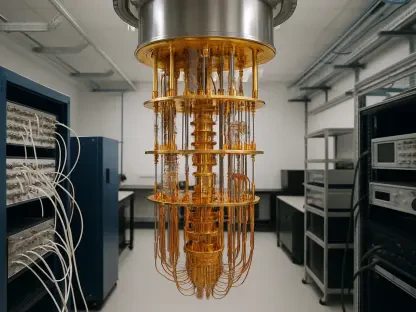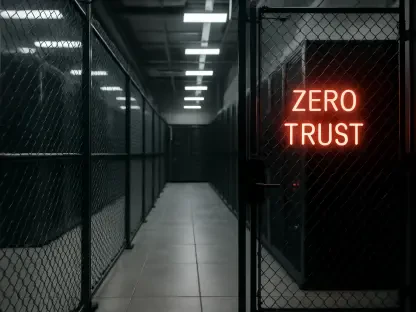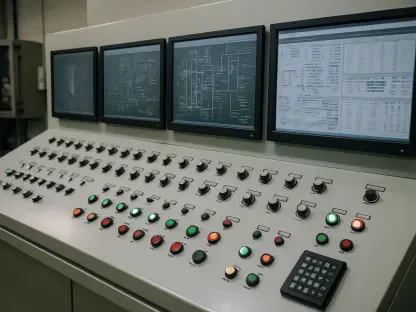As the demand for artificial intelligence applications continues to surge, data centers find themselves at the heart of this technological evolution. The rapid expansion of AI-driven solutions—from drug discovery to autonomous vehicles—has amplified the need for robust infrastructure capable of accommodating increasingly powerful computational workloads. With projections indicating the AI data center market will leap from $236 billion in 2025 to an astounding $933 billion by 2030, operators are compelled to address the critical challenge of energy consumption. Cooling systems are central to this issue, consuming a significant portion of operational energy. Old air-cooling methods fail to efficiently dissipate the heat generated by high-performance hardware such as GPUs. This inefficiency drives the industry towards innovative solutions like liquid cooling, which promise enhanced energy efficiency. With the spotlight on sustainability and cost control, these cooling advancements are not just a technological necessity but a pivotal strategy for profitable and eco-friendly operations.
Innovative Cooling Solutions and Their Impact
With the limitations of traditional cooling methods in stark relief, the industry sees a pivotal shift towards groundbreaking technologies like those provided by Basx Technologies. Liquid cooling systems, engineered to manage heat far more adeptly than air cooling, emerge as a vanguard in this transformation. Applied Digital, a frontrunner in embracing such innovations, reports impressive energy savings—up to 30-40%—due to the adoption of Basx’s custom cooling solutions. This results in a power draw as low as 0.065kW per ton, indicating considerable efficiency gains compared to legacy systems. The migration to sophisticated cooling is not purely an operational upgrade; it carries significant financial implications. These savings contribute directly to the bottom line, underscoring the integral role of advanced cooling in enhancing competitiveness. As AI workloads demand more from infrastructure, the strategic pivot to innovative cooling stands as a cornerstone of long-term viability and growth in the data center sector.
Beyond energy savings, the strategic alignment around innovative cooling solutions shapes the competitive landscape. Applied Digital’s strategic partnership with CoreWeave exemplifies this. A substantial $7 billion, 15-year lease agreement secures Applied Digital’s operations while reinforcing market confidence. The partnership represents more than financial commitment; it attests to the trust in sustainable operational models powered by cutting-edge cooling technology. This collaboration assures scalability, allowing Applied Digital to reliably meet growing data demands in the AI space. By leveraging a modular approach, the company sidesteps typical expansion risks, facilitating rapid growth without costly inefficiencies. These partnerships and strategic choices demonstrate how integrating advanced cooling technologies within business models not only meets immediate needs but also positions companies for forward-thinking scalability—strengthening long-term revenue prospects and market positioning.
Geographical and Strategic Advantages
The deployment of data centers in favorable locations presents significant competitive advantages, as demonstrated by Applied Digital’s operations in North Dakota. This choice taps into the region’s cold climate and surplus electricity from stranded power assets, providing an inherent reduction in operational costs. The Polaris Forge 01 facility, boasting a capacity of 100MW, embodies this advantage, delivering annual savings between $50 to $60 million compared to traditional setups. It achieves a remarkable Power Usage Effectiveness (PUE) score of just 1.18, well below the prevailing industry average of 1.5 to 2.0, reflecting its superior efficiency. Geographical positioning coupled with state-of-the-art cooling systems amplifies Applied Digital’s economic resilience, positioning it as a standout in the competitive landscape.
Moreover, the strategic geographic location of these data centers aligns with broader infrastructural goals. In North Dakota, early investments in power assets foster a secure energy supply, mitigating risks associated with power shortages. This foresight is further bolstered by a $5 billion financing agreement with Macquarie, safeguarding growth with minimized leverage. The company’s Ellendale campus, set to host 400MW of capacity, exemplifies scalability, supported by modular design and adaptable cooling systems. Such strategic positioning and intentional design integrate environmental efficiency, cost management, and secure energy resources. Together, they represent a robust model that not only addresses immediate operational needs but anticipates future demand, ensuring stability amidst a rapidly evolving economic landscape in the AI data center sphere.
Sustainability and Future Growth
Sustainability has become indispensable in strengthening data center operations and corporate strategies. Applied Digital’s commitment to environmental mandates, reflected in its ESG focus, aims for a complete transition to renewable energy by 2030. Currently sourcing 20% of energy from renewables, efforts to elevate this percentage are underway, supported by investments in solar and wind projects. The EDGE2 facility in Jakarta serves as a testament to this initiative, operating at a PUE of 1.25 through solar power utilization. Combined with closed-loop liquid cooling systems, which approach zero Water Usage Effectiveness (WUE), Applied Digital is pioneering resource-conscious methods that significantly conserve water. Further community engagement, such as the R-WISH program addressing regional housing shortages, enhances their impact, leading to deserved recognition like the DCD Community Impact Award.
Looking forward, the evolving AI data center market presents both challenges and opportunities. Applied Digital exhibits adaptability by navigating potential barriers such as power shortages and capital costs. Early strategic investments and substantial financing arrangements have positioned the company to capitalize on growth, mitigating risks of heavy borrowing. As tech giants like Google and Microsoft pursue AI-specific centers aggressively, Applied Digital’s unique offerings demonstrate a potent niche within this competitive field. In regions like the Asia Pacific, escalating investments in AI infrastructure signal broader applicability, while U.S. policy supports green technology expansion. These factors, coupled with Applied Digital’s exemplary model, present a promising outlook for sustained success and innovation in the data center industry.
Concluding Reflections
As the demand for artificial intelligence (AI) applications skyrockets, data centers stand at the forefront of this technological boom. AI solutions, ranging from drug discovery to autonomous vehicles, necessitate a robust infrastructure to handle vastly powerful computational tasks. Forecasts predict the AI data center market will grow from $236 billion in 2025 to an impressive $933 billion by 2030. This growth pushes operators to confront the significant challenge of energy consumption. Central to this issue are cooling systems, which consume a large portion of operational energy. Traditional air-cooling methods struggle to efficiently dissipate the immense heat generated by high-performance hardware such as GPUs. Consequently, the industry is shifting towards innovative solutions, like liquid cooling, which offer improved energy efficiency. In today’s world, where sustainability and cost control are key, these advancements are not just technological necessities but critical strategies for ensuring profitable and environmentally friendly operations.









